The U.S. Army has released a request for proposals, or RFPs, to procure additional rifleman radios using full and open competition.
The RFP, which was posted Jan. 5 to the Federal Business Opportunities website, moves the Army toward full-rate production, or FRP, for the rifleman radio, part of the Handheld, Manpack and Small-form Fit, known as HMS, program. Contract awards are expected in Fiscal Year 2015, and initial radios provided in Fiscal Year 2015 will be used for qualification testing. FRP will begin in Fiscal Year 2017.
Under the full and open competition approach, the Army will award contracts to multiple vendors, creating a “radio marketplace” where vendors will compete for delivery orders as needed, after they achieve technical and operational requirements.
“The full and open competition gives all vendors the opportunity to participate as we work together to deliver the most technologically-advanced and user-friendly radios for Soldiers,” said Col. James P. Ross, project manager for Tactical Radios. “Our goal is to field radios that not only consistently improve their capabilities, but also get simpler for Soldiers to operate.”
The indefinite delivery, indefinite quantity, or IDIQ, contract will be awarded to multiple vendors who meet the technical requirements. The contract will have a five year base ordering period with an optional five year ordering period. This structure enables the Army to choose from numerous technologies, and release a new contract if radio technology changes significantly.
The competitive non-developmental item, or NDI, acquisition strategy is expected to reduce radio procurement costs as the Army continues to modernize the tactical communications network amid fiscal constraints.
The Army plans to award contracts to multiple qualified vendors. Once the contracts are awarded, each radio will undergo laboratory tests to determine if threshold requirements have been met. Vendors that do not meet their contract requirements will be off-ramped. Vendors that do meet the qualifications may move to the next phase, an operational test to be performed at one of the Army’s Network Integration Evaluations, known as NIEs. The acquisition strategy includes on-ramp opportunities for vendors whose technologies mature after the initial competition and operational tests.
With each new generation, the Army plans to procure radios with better capabilities, including faster processors, increased power and battery life and decreased weight.
In response to comments from industry day events, the Army added additional objective requirements including a two channel hand-held rifleman radio. This will give the Army the flexibility to procure this radio under this contract vehicle if the requirement is leveraged on the HMS program. By using the Single Channel Ground and Airborne Radio System, or SINCGARS, waveform and the Soldier Radio Waveform, known as SRW, the rifleman radio will enable communication on both channels simultaneously. The range, however, will not be as strong as its sister radio, the Manpack.
“As an objective requirement, vendors do not have to provide a two-channel hand-held rifleman radio to get a contract,” said Lt. Col. Rayfus Gary, product manager for HMS. “We look forward to seeing what vendors have to offer in both single-channel and two-channel solutions.”
The rifleman radio is a lightweight, rugged, hand-held radio that transmits voice and data past terrain obstacles and beyond line of sight via the SRW. Carried by Soldiers at the platoon, squad and team levels, the rifleman radio uses SRW to transmit information up and down the chain of command, as well as into the network backbone provided by the Warfighter Information Network-Tactical, or WIN-T.
The rifleman radio can also be linked to Nett Warrior, using a secure Android phone type device that enables Soldiers to send messages, access mission-related applications and track one another’s locations with GPS technology.
Through low rate initial production, the Army has already purchased 21,379 rifleman radios. The radios, fielded as part of the integrated Capability Set, known as CS, 13 network package, are supporting dismounted operations in support of the advise-and-assist mission in Afghanistan. Fielding is underway to additional BCTs as part of CS 14, with eventual fielding planned across the entire force.











